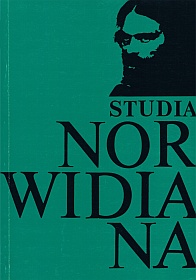Self-Creation in Promethidion
Abstract
Norwid intended his poem Promethidion, written and published in the middle of the 19th century, as a programme piece, a statement of particular significance in the face of the literary transformations and new artistic tendencies of the time. Yet the poem failed to fulfill that role. Blamed for being obscure and chaotic, it was rejected by the readers.
The author of the article considers the causes of such opinions and puts forward the thesis that one of the reasons why the poem was misunderstood was the polyphonic and fluid mode of creation of its subject, which has all the marks of self-creation. The proximity of the subject to the author's self-image in this case does not yield unequivocal senses. The multiplicity of perspectives in the poem is connected with the way Norwid styles his “self”. The author discerns three types of stylization: Socratic stylization, the mask of a gladiator and the mask of a prophet.
The first of these has to do with Norwid's choice of the Platonic dialogue as his genological model. The analysis of the situation and of the structure and subject-matter of the discourse reveals parallelisms between Norwid's dialogue Bogumił and Plato's Symposium. The title character's part in Norwid's poem is analogous to the part of Socrates in the Symposium. This makes possible the Socratic stylization of Bogumił, who is the author's mouthpiece in the poem. In this way Socrates becomes part of the author's self-image.
The gladiator “mask” is well inscribed in the traditional use of the motif by the literature and art of the 19th century. In Promethidion it appears in the mottos, and it acquires special significance in the concluding section of the dialogue Wiesław. Norwid associates the motif with the category of truth. The image of a champion fighting in the arena is a figure of all struggle against falsehood, a symbol of the fate suffered by those who proclaim difficult truths and are therefore rejected by their contemporaries. Under this interpretation, the gladiator's fate is astonishingly close to the fate of the prophet.
The prophetic stylization of the subject invokes three traditions: the Old Testament, the Pauline letters and the attitude of the poet-prophet as expressed in Romantic poetry, especially the Dresden parts of Mickiewicz's Forefathers' Eve. The stylization is connected with the attitude that the poem advocates: an attitude of one searching for truth and serving it regardless of circumstances.
In the Epilogue the three motifs are brought together. The multiplicity of perspectives is reduced to the single common denominator of the author's own position. Another point that the three figures, Socrates, the gladiator and the prophet, have in common is that each of them is a sign of critical change and in some respect an anticipation of Christianity. The complex literary self-portrait in Promethidion is evidence of Norwid's effort to internalize tradition and make it a part of his own spiritual and intellectual biography.
Copyright (c) 1991-1992 Studia Norwidiana

This work is licensed under a Creative Commons Attribution-NonCommercial-NoDerivatives 4.0 International License.





